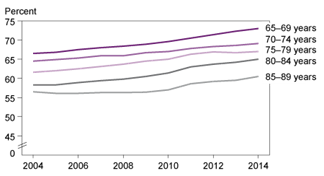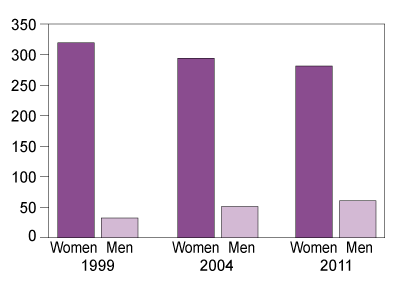Women and men in Sweden 2016:
Women have lower salaries, incomes and pensions than men
Statistical news from Statistics Sweden 2016-07-04 9.30
Women and men are found in different occupations on the labour market. This partly explains the differences in pay between women and men. Women work more often part-time, which result in differences in income, leading to considerably lower pensions. These are only a few items you can read about in "Women and men in Sweden 2016" which is being published today.
The overall goal of the government for gender equality policy is to ensure that women have the same power to shape society and their own lives. Among other things, this means that women and men must have the same opportunities and terms as regards education and paid work that provides economic independence throughout their lives.
Small steps towards gender equality regarding wages and salaries
In terms of the entire labour market, women earn 87 percent of what men earn, when all pay is recalculated to full-time. The most important reason that the picture looks like this is because women and men are found in different occupations and the occupations dominated by men tend to pay better salaries than the occupations dominated by women. Here we see a slight change since the last edition of "Women and men in Sweden" that was published in 2014. At that time, women earned 86 percent of what men earned.
With the help of the statistical method of standard weighting, it is possible to take consideration to factors such as different occupational choices of women and men, different educational paths etc. By doing so, we obtain differences that cannot be explained with the help of statistics. With this method, differences in pay are smaller and women earn 94 percent of what men earn. Even here the difference has dropped by one percentage point since the 2014 edition.
Part-time and care of children result in lower incomes and pensions
When consideration is also taken to the fact that more women than men work part-time, take longer parental leave and care for sick children to a greater extent than men, the differences between women's and men's annual income is even higher. Women earn 81 percent of what men earn, compared to 80 percent two years ago. So how does economic independence look for an entire lifetime? When working life comes to an end, women on average receive 67 percent of what men receive in pension funds, the younger women somewhat more and the older ones somewhat less.

Even when it comes to pensions a slight improvement has occurred since the last edition of "Women and men in Sweden". At that time, women's pensions equalled 66 percent of those of men.
One of several explanations why women have lower incomes and later on even lower pensions can be found in the third of the gender equality policy goals: "an even distribution of unpaid work for the household and child care". Parental allowance includes 480 days that a parent can use over a long period. However, the parents use most of the days by the time the child is two years old.

By that time, mothers have used 82 percent of the days and fathers have used 18 percent of the days.
Sex distribution is even in the Riksdag but not in the board rooms
An even distribution of power and influence is another gender equality policy goal. "Women and men in Sweden" presents statistics on power and influence in many areas. The sex distribution in Swedish Parliament is even. In other positions of power such as managers in the private sector, sex distribution is not even, but at the same time it is far from the uneven situation among chairpersons on the boards of listed companies. There, 5 percent are women and 95 percent are men; this is the same distribution as two years ago when Statistics Sweden last published the booklet.
"Women and men in Sweden" was first published in 1984 and is published every other year in Swedish and in English. The booklet presents statistics on the terms for women and men in Sweden within many areas.
Publication
The full publication is available on Statistics Sweden's website.
Feel free to use the facts from this statistical news but remember to state Source: Statistics Sweden.
